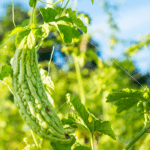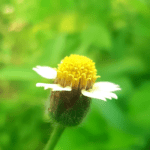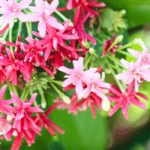Sahadevi – The Purple Fleabane Plant – An Introduction
The Sahadevi plant, scientifically known as Vernonia Cineria or Cyanthillium Cinereum, is a medicinal herb found in India. It has been used for centuries in traditional medicine due to its numerous health benefits. It belongs to the Asteraceae family. It is a small flowering plant that can reach a height of up to 60 cm. The leaves are hairy with a purplish hue, and the flowers are purple or pink in color. Sahadevi is native to India and can be found all over the country, especially in the temperate climate regions. In this article, we will delve into the various medicinal properties of Sahadevi and explore how to grow this remarkable plant.
Overview of Sahadevi
Sahadevi is also known as Purple Fleabane or Little Ironweed

Other Common Names and Synonyms
Sahadevi is known by different names in various languages. In English, it is commonly referred to as Purple Fleabane or Little Ironweed. In Hindi, it is called Sahdevi, while in Kannada it is known as Anjanam. In Tamil, it is referred to as Poovamkurunnila, and in Telugu, it is known as Podha. In Marathi, it is called Sahadi and Amygdalina. These various names reflect the plant’s popularity and widespread use across different regions.
Medicinal Benefits of Sahadevi
Sahadevi has long been recognized for its medicinal properties. In Ayurvedic medicine, it is commonly used to treat various conditions. The plant extracts are known for their therapeutic effects and have been found to possess anti-inflammatory properties. Sahadevi is also believed to help in treating intermittent fever, thanks to its ability to induce sweating and reduce body temperature.
Medicinal Uses in Ayurveda
In Ayurvedic pharmacopeia, Sahadevi holds a significant place due to its wide array of medicinal properties. The plant extracts are known for their diaphoretic and anthelmintic properties, making them effective in treating fevers and various digestive disorders. Sahadevi has been traditionally used to treat colic, cough, and filariasis, among other ailments.
Growing Sahadevi
If you are interested in growing Sahadevi in your own garden, it is important to know the proper techniques. Sahadevi can be grown from seeds, which should be planted in well-drained soil during the rainy season. The plant requires regular watering and should be exposed to sunlight for at least 4-6 hours a day. Once the plant reaches maturity, you can harvest the flowers for further use.

Chemical Properties
Sahadevi contains various chemical compounds that contribute to its medicinal properties. It is rich in flavonoids, alkaloids, and phenolic compounds, which have antioxidant and anti-inflammatory effects. These compounds help in reducing inflammation, boosting the immune system, and providing relief from pain and discomfort.
Cyanthillium Cinereum – A Medicinal Herb – Its benefits and uses
Overview of Cyanthillium Cinereum Herb
Cyanthillium Cinereum is another name for Sahadevi, and this versatile medicinal herb deserves a closer look for its therapeutic properties. The plant is characterized by its hairy leaves and striking purple flowers, adding beauty to any garden while offering numerous health benefits.
Uses and Benefits
The whole plant of Cyanthillium Cinereum is considered valuable in Ayurveda due to its various medicinal uses. It is widely used in traditional medicine to treat intermittent fevers and as an anti-inflammatory agent. The herb’s extracts are known for their potential in alleviating various ailments and promoting overall well-being.
Growing Cyanthillium Cinereum
Just like Sahadevi, growing Cyanthillium Cinereum is relatively straightforward. This herbaceous plant requires similar conditions, such as well-draining soil and moderate sunlight. By providing the right environment and care, you can cultivate this herb and harness its therapeutic potential.

Medicinal Properties
Cyanthillium Cinereum exhibits a range of medicinal properties, making it a sought-after herb in Ayurveda. Its extracts have shown promising results in treating fevers and inflammatory conditions. As a part of Ayurvedic medicine, it is used to create decoctions and extracts that target specific health concerns.
Ayurvedic Medicine and Applications
Ayurvedic practitioners have incorporated Cyanthillium Cinereum into various formulations and remedies due to its multiple healing properties. The herb is an essential component of Ayurvedic treatments aimed at promoting health and addressing specific health conditions.
Buying Cyanthillium Cinereum Plant Seeds and Photos
If you’re interested in cultivating Cyanthillium Cinereum in your garden, you can find its seeds online or at specialized nurseries. It’s recommended to source authentic seeds to ensure the best results. Additionally, you can refer to reliable sources for photos of the plant to familiarize yourself with its appearance.
How to Grow Sahadevi Plant?
Planting Sahadevi Seeds
To grow Sahadevi, you can start by planting its seeds in well-prepared soil. Plant the seeds with a spacing of 8-10 cm between each seed. Ensure that the soil is well-drained to prevent waterlogging, as it can harm the plant’s growth. Water the seeds regularly, but avoid overwatering, as it can lead to root rot. The seeds should germinate within 2-3 weeks, and you can expect the plant to reach maturity in 3-4 months.

Seeds of Little Ironweed flowers which is botanically known as Cyanthillium Cinereum
Caring for Sahadevi Plant
The Sahadevi plant requires regular care to thrive. It should be provided with sufficient sunlight, preferably 4-6 hours a day. The soil should be kept moist but not waterlogged, as this can cause root rot. Fertilize the plant every 4-6 weeks with a balanced organic fertilizer to promote healthy growth. Prune the plant regularly to maintain its shape and remove any dead or yellowing leaves.

Harvesting and Using Sahadevi Flowers
Once the Sahadevi plant reaches maturity, you can harvest the flowers for further use. The flowers can be plucked when they are in full bloom, usually during the morning hours. To maximize the medicinal benefits, it is recommended to use the flowers immediately or dry them for future use. Sahadevi flowers can be used to prepare decoctions, extracts, or even consumed in the form of tablets or juice.

Exploring the Ayurvedic Properties of Sahadevi / Vernonica Cinerea / Cyanthillium Cinereum
What are the Medicinal Properties of Sahadevi?
Health Benefits of Sahadevi
Sahadevi offers a wide range of health benefits. It improves digestion, boosts the immune system, and promotes overall well-being. The plant’s anti-inflammatory properties make it effective in reducing pain and inflammation caused by various conditions. Sahadevi is also known for its antipyretic properties, which help in reducing fever and providing relief from related symptoms.

Traditional Uses of Sahadevi in Ayurveda
In Ayurveda, Sahadevi has been used for centuries to treat various ailments. It is believed to have a balancing effect on the doshas and helps in maintaining optimal health. Ayurvedic practitioners recommend Sahadevi for its diuretic properties, promoting urinary health and cleansing the body of toxins. It is also used to improve respiratory health and alleviate symptoms of respiratory disorders.
Using Sahadevi in the Treatment of Intermittent Fever
Sahadevi has been traditionally used to treat intermittent fever. It is believed to help in reducing body temperature and inducing sweating, which aids in fever reduction. The plant’s antipyretic properties make it a valuable natural remedy for fever management. Sahadevi can be consumed in the form of decoction or as directed by an Ayurvedic practitioner.
Other Uses of Sahadevi
Alternative Uses of Sahadevi
Apart from its medicinal uses, Sahadevi has other alternative applications. It is believed to have potential anti-inflammatory effects, making it beneficial for relieving pain and discomfort caused by inflammatory conditions. Some people also use Sahadevi in skincare, as it is believed to improve skin health and treat certain skin disorders.
The Importance of Sahadevi in Ayurvedic Medicine
Sahadevi holds great importance in Ayurvedic medicine. It is considered one of the key herbs used in various formulations and preparations. Its wide range of medicinal properties contributes to its significance in Ayurvedic practice. Sahadevi plays a vital role in promoting overall well-being and maintaining optimal health.
Potential Anti-inflammatory Effects of Sahadevi
Research suggests that Sahadevi possesses potential anti-inflammatory effects. It can help in reducing inflammation, which is often the root cause of many chronic health conditions. Sahadevi’s anti-inflammatory properties make it a valuable herb in the management of inflammatory disorders.
People Also Ask FAQs (with short answers)
Where should we keep Sahadevi plant at home?
The Sahadevi plant thrives in bright, indirect sunlight. It is best to place it near a window where it can receive sufficient light without being exposed to direct sunlight for prolonged periods. Ensure that the room temperature is moderate and avoid placing it in drafty areas.
What is the plant of Sahadevi?
Sahadevi, scientifically known as Vernonia Cineria or Cyanthillium Cinereum, is a small flowering plant belonging to the Asteraceae family. It is renowned for its vibrant purple or pink flowers and has significant medicinal properties used in traditional Ayurvedic medicine.
Is Sahadevi an indoor plant?
Yes, Sahadevi can be grown as an indoor plant, making it a delightful addition to your home garden. However, it requires moderate sunlight and well-draining soil to thrive. Ensure adequate care and provide the right conditions to promote its growth indoors.
How do you care for a Sahadevi plant?
To care for a Sahadevi plant, make sure to place it in a location with bright, indirect sunlight. Water it regularly, but avoid overwatering as it may lead to root rot. Use well-draining soil and provide occasional fertilization to support its growth. Prune the plant as needed to maintain its shape and remove any dead or damaged foliage. With proper care, your Sahadevi plant will flourish and reward you with its beauty and health benefits.
What are the benefits of Sahadevi plant?
Sahadevi plant has various medicinal benefits. It is believed to have a protective effect on the liver, helps in colic and cough, and is even claimed to have anticancer properties.
What does Sahdevi plant look like?
Sahdevi plant is a small shrub with purple or pink-colored blooming flowers. The plant has a hairy surface beneath its leaves and flowers.
Where can I find images of Poovamkurunnila plant?
You can find images of Poovamkurunnila plant, which is another name for Sahdevi plant, online or by searching in herbarium collections.
What is the Hindi name for Sahdevi plant?
The Hindi name for Sahdevi plant is “Sahdevi ka Paudha”.
Can Sahdevi plant be found throughout India?
Yes, Sahdevi plant can be found all over India, especially in temperate climates.
What are the common uses of Cyanthillium cinereum?
Cyanthillium cinereum, also known as Sahdevi plant, is used in traditional medicine to treat various ailments like colic and cough. It is also believed to have a protective effect on the liver.
Does Sahdevi plant attract bees and butterflies?
Yes, Sahdevi plant is known to attract bees and butterflies due to the blooming flowers.
Is Sahdevi plant beneficial for any specific health condition?
While Sahdevi plant is believed to have various medicinal properties, it is especially known for its beneficial effects on the liver and its potential anticancer properties.
What are the possible uses of Sahdevi plant?
Sahdevi plant is used in traditional medicine to treat colic, cough, and other health conditions. It is also believed to have potential anticancer properties.
What is Sahdevi ka Ped?
Sahdevi ka Ped is a small shrub that is commonly found all over India in temperate climates. It is also known as sahadevi plant in Hindi and vernonia cinerea in botanical terms.
Conclusion – Is Growing Sahadevi Plant / Vernonia Cineria Worth It?
As we step into the realm of Ayurvedic properties and applications, we are reminded of the time-honored wisdom of traditional medicine. Sahadevi, Vernonica Cinerea, and Cyanthillium Cinereum stand as timeless symbols of the healing power of nature. Their role in Ayurvedic treatments reflects the harmony between humans and the natural world, encouraging us to embrace holistic approaches to well-being.
Sahadevi, also known as Purple Fleabane or Little Ironweed, is a remarkable plant with numerous medicinal properties. Its use in traditional medicine, especially Ayurveda, is well-documented. From its ability to treat various ailments to its anti-inflammatory effects, Sahadevi offers a range of health benefits.
In conclusion, growing Sahadevi and exploring its wonders is not just a gardening endeavor but an exploration of ancient wisdom and nature’s bounties. It is a journey of discovery that brings us closer to the essence of life and the healing touch of Mother Nature. So, let us embark on this enriching voyage, nurturing the enchanting Sahadevi plant and celebrating its medicinal marvels with open hearts and open minds.
For a wide selection of fertilizers and soil amendments suitable for all these plants, we invite you to explore our esteemed webstore at www.shehrikisaan.com. Our webstore offers a comprehensive range of products designed to enhance the growth and vitality of your plants.
Whether you’re seeking specialized fertilizers, organic amendments, or premium-quality soil enhancers, our webstore is your one-stop destination. With our commitment to providing garden enthusiasts with top-notch products, you can trust us to cater to your gardening needs effectively. Visit www.shehrikisaan.com today and unlock the secret to flourishing plants.
Discover our Social Media Presence and web store. Choose your favourite platforms:
🌐 Google Business Link: https://goo.gl/maps/wgs6yU8mArXRfHdi9
🎥 YouTube: https://www.youtube.com/@shehrikisaan
💼 LinkedIn: https://www.linkedin.com/company/shehrikisaan/
📌 Pinterest: https://in.pinterest.com/ShehriKisaan/
📘 Facebook: https://www.facebook.com/ShehriKisaan/
📷 Instagram: https://www.instagram.com/shehrikisaan_gn/
🐦 Twitter: https://twitter.com/Shehri_Kisaan
🛒 Product Web Store: www.shehrikisaan.com
📚 Check out our other articles, education materials, blogs, and write-ups too: www.shehrikisaan.in







